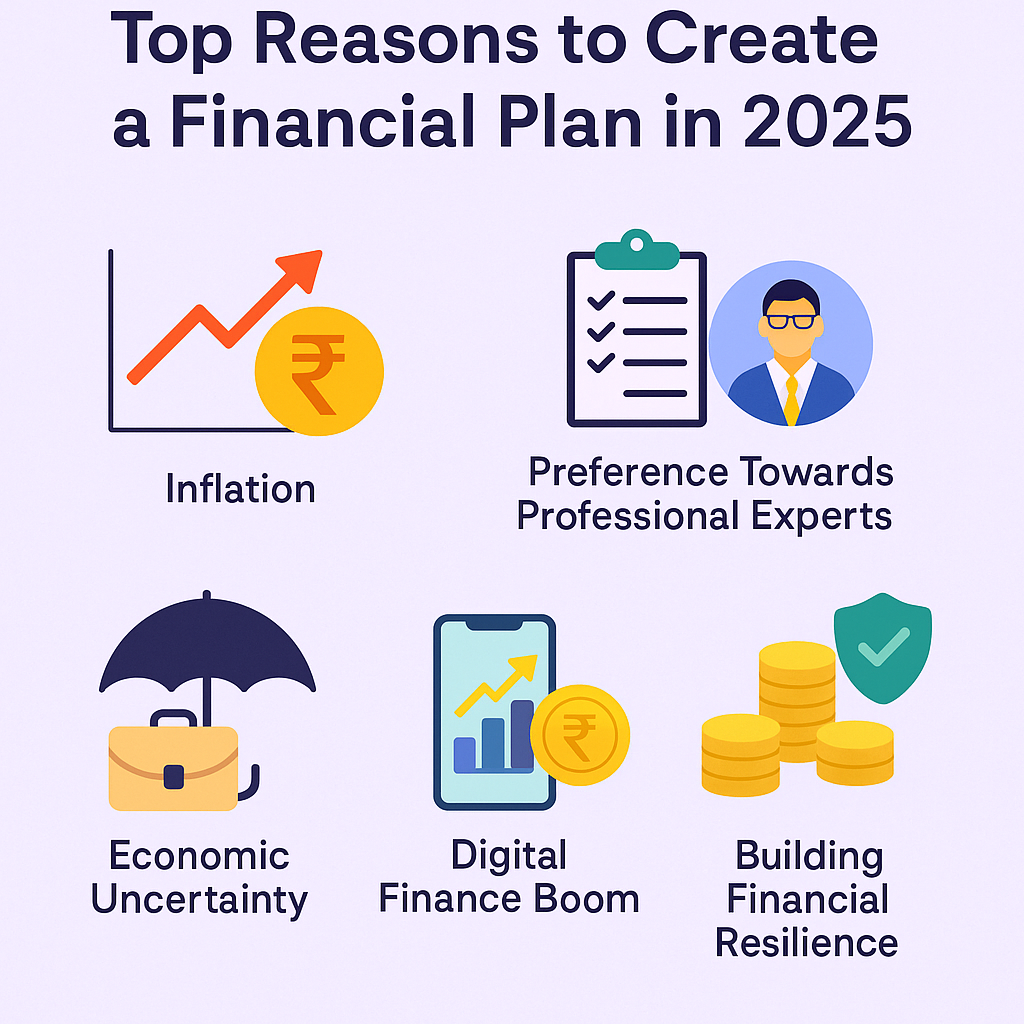Want financial clarity? Read about the top 5 objectives of financial planning here in-detail in this blog!
Many of us struggle with managing expenses, saving for our goals, or feeling confident about our future. Without a clear plan, financial stress can stand in the way of achieving your financial dreams. That’s where financial planning can help, it gives you control and peace of mind. In fact, an FPSB report found that 80 out of 100 Indians say professional financial planning has improved their quality of life.
At its core, financial planning is about assessing your current financial situation, setting clear objectives, creating a budget, choosing suitable investments, and regularly reviewing your progress. When you understand the key objectives of financial planning, you’re better equipped to build a strong, secure financial future. In this blog, we’ll discuss the top five objectives you should know.
Core Objectives of Financial Planning: Explained
In order to understand the objectives of financial planning thoroughly, it’s important to know what these goals actually look like in practice. Core objectives serve as a roadmap, helping you align your financial habits with your life priorities and future needs.
- Goal‑Setting & Cash‑Flow Management
Every effective financial plan starts by defining your goals clearly across three time horizons: short-term (under 1 year), medium-term (1–5 years), and long-term (5+ years).
Assigning amounts and timelines gives you concrete targets, like saving ₹50,000 for a trip or building a retirement corpus through NPS or PPF.
Once goals are set, track cash flow by recording income, expenses, assets, and liabilities. This identifies overspending, frees up savings, and keeps liquidity healthy. Use tools like spreadsheets or budgeting apps to categorize expenses, set reminders, and visualize trends. Make sure to update them monthly to stay on track.
- Building an Emergency Fund & Debt Strategy
A financial safety net protects against job loss or emergencies. Build an emergency fund equal to three to six months’ essential expenses, keeping it in liquid, low-risk options like savings accounts or liquid funds for quick access.
Managing debt goes hand in hand with building liquidity. Prioritise paying off high-interest debts like credit cards to save on interest costs and improve your credit score. Use a simple tracker to:
- List debts with interest rates
- Track repayment progress monthly
- Monitor outstanding balances
This keeps you disciplined while balancing debt reduction and emergency savings.
- Investment & Savings Plan
Once your emergency fund is in place and debts are under control, the next objective is to start building wealth through methodical investment and savings plan. Each goal should align with appropriate investment vehicles that match your timeline and risk appetite. For medium- to long-term goals, options like NPS, PPF, or mutual funds, which come with a lock-in period can be effective for creating a retirement corpus or funding children’s education.
Diversifying your portfolio across asset classes such as equity funds for growth, debt funds for stability, and gold for hedging inflation helps manage overall risk. As you invest, aim for inflation-beating returns ensuring your savings grow in real terms and your purchasing power is preserved for the future.
- Risk Management & Protection
Protecting what you’ve built is just as vital as accumulating wealth. Comprehensive insurance coverage including health, life, accident, and property acts as a safeguard against unexpected setbacks. Adequate health insurance ensures hospitalization costs don’t erode your savings, while life insurance provides for your family in your absence.
You can also utilise tax benefits while protecting your finances:
- Section 80C: Premiums for life insurance, contributions to PPF, ELSS, NPS
- Section 80D: Premiums for health insurance
Estate planning tools like wills or trusts guarantee that your assets are transferred according to your wishes, and reviewing nominations on insurance and investments helps avoid legal disputes later.
- Regular Monitoring & Plan Adjustment
Lastly, financial planning isn’t a set-and-forget exercise, it needs to adapt with your changing life, goals, and financial environment.
Regular reviews, ideally once a year, let you reassess goals, analyse cash flow, and update investments or insurance to stay aligned with your priorities. During each review:
- Compare targets vs. actuals for savings and expenses.
- Assess portfolio performance and rebalance if asset allocation drifts by 5–10%, meaning if your investments move away from your target mix, adjust them to stay aligned with your financial plan.
- Adjust for life changes, such as a promotion, marriage, or new family member, which may require updating goals, insurance coverage, or contributions.
Additionally, use tools like budgeting apps, account-syncing platforms, and portfolio trackers with visual dashboards to automate tracking, ensure accuracy, and gain real-time insights, keeping your financial plan effective and up to date.
CASE STUDY:
Roger (29) and Angela (28), a young couple from Ahmedabad, knew they had to plan carefully for their children’s future milestones: education and marriage. With rising costs driven by inflation, they realized casual savings wouldn’t suffice; a systematic financial plan was essential.
They started by estimating future costs, using an 8% annual inflation rate for education and 9% for marriage. Their plan focused on three priorities:
- Setting realistic targets for education and marriage expenses.
- Building an emergency fund covering six months of essential costs.
- Securing comprehensive health and life insurance for financial protection.
Their investments balanced long-term growth and safety through equity mutual funds, PPF, and fixed deposits. As each goal approached, they planned to gradually shift funds from equity to safer assets to reduce risk. To address a projected shortfall of around 16–20% in marriage funding, they earmarked additional mutual funds and fixed deposits as backup. Annual reviews were scheduled to adjust contributions, rebalance the portfolio, and align with salary increments and changing family needs.
Let’s look at the core elements of their plan in detail:
| Financial Metric | Target/Value | Purpose |
| Children’s Education Cost | ₹50 lakh per child (in 15 years) | Corpus needed to fully fund higher education |
| Children’s Marriage Cost | ₹35 lakh per child (in 22 years) | Target amount, accounting for a potential shortfall |
| Emergency Fund | 6 months’ essential expenses | Safety net for unforeseen situations |
| Investment Allocation | Equity (70%), PPF (20%), FDs (10%) | Blend of growth, tax efficiency, and liquidity |
| Projected Shortfall | ₹12 lakh (for marriage) | To be covered through backup MFs and FDs |
This structured approach empowered Roger and Angela to confidently prepare for their children’s future milestones while maintaining financial stability and flexibility. By staying disciplined with regular reviews, they ensured their plan could adapt to changes in income, expenses, or unexpected life events giving them peace of mind today and security for tomorrow.
Top Reasons to Create a Financial Plan in 2025

If you want to stay financially secure in 2025, having a clear financial plan is now more important than ever. Here’s why:
- Inflation
Prices in India are expected to rise by 4.8% in 2025, affecting your daily costs more than before. This means everything from groceries and fuel to education and healthcare will cost significantly more. Planning your expenses and investments will help you protect your money’s value over time and secure your lifestyle.
- Preference Towards Professional Experts
India saw a 17.7% rise in Certified Financial Planners (CFPs) in 2024, showing that families want help to make smart choices. This growing trend highlights how important expert guidance has become for setting financial goals, building wealth, and avoiding costly mistakes in an unpredictable economy.
- Economic Uncertainty
With unemployment at 5.6%, income can be less stable for many households. A proper plan helps create a strong safety net in case of job loss, reduced earnings, or sudden expenses, so you can maintain financial stability even when times get tough.
- Digital Finance Boom
SIP inflows reached a record ₹26,688 crore in early 2025, reflecting the digital investment boom. More people are using easy-to-access online platforms to invest regularly, automate savings, and steadily build wealth with greater convenience than ever before.
- Building Financial Resilience
A good plan helps you save consistently, lower unnecessary debt, and earn from different sources. By building financial strength, you can better handle life’s ups and downs and stay prepared for emergencies or opportunities that may come your way.
Conclusion
A thorough understanding of key objections of financial planning gives you an edge in managing risks, building savings, and achieving your ambitions with confidence. Don’t let uncertainty derail your progress, create a plan that adapts to your life’s changes. To make the most of your efforts, speak to a qualified trading or financial professional who can help you fine-tune your strategy and reach your goals.
DISCLAIMER: The information given in this blog is for educational purposes only. Any content of this blog is not investment advice.
- Nifty & Sensex — how to get live updates quickly - November 4, 2025
- Not Diamonds, Gold is the Indian Woman’s Best Friend Forever - October 30, 2025
- IdeaForge, Paras Defence, BEL, HAL – Defence & Drone Push Offers Compelling Narratives - October 7, 2025





